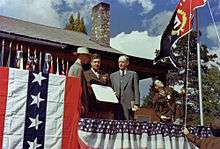Army-Navy "E" Award

The Army-Navy "E" Award was an honor presented to a company during World War II for excellence in production of war equipment. The award was also known as the Army-Navy Production Award. The award consisted of a pennant for the plant and emblems for all employees in the plant at the time the award was made. The pennant was triangular swallowtail with a white border, with a capital E within a yellow wreath of oak and laurel leaves on a vertical divided blue and red background. ARMY is on the red background and NAVY on the blue background.
Usually an Army officer and a Navy officer would be present at a ceremony when a company would assemble all the employees and a ceremony would ensue. After the award of the pennant to the plant (to be flown), the employees present would receive their pins. A total of 4,283 companies received the award in the course of the war.[1] This amounted to about 4 percent of the companies engaged in war work. Plants with continuing excellent work were awarded stars to add to their pennant. A handful of plants earned up to six stars by the end of the war. The Army-Navy "E" Award program was terminated after the war ended.
History

Initially, the awards were created during Theodore Roosevelt's administration.[2] The award was a Navy E-Award, which was to commend superior naval service. Later awards continued in World War I and until early in World War II were the Navy E, the Army A and the Army-Navy Star.
World War II
In order to encourage industrial mobilization an award was created to encourage production of war time materials. The Army-Navy E-Award came into existence in July 1942 when the Navy E and Army-Navy Munitions Board Award were merged.[3]
All factories engaged in war production were eligible to receive the award. Government as well as privately owned plants were eligible, as were contractors.[4]
Although the award was granted to industry, one academic institution and one individual received it. Iowa State College (now Iowa State University) received the award for its contribution to the production of uranium for the Manhattan Project. Dr. Harley A. Wilhelm received the award for inventing the Ames process for the extraction, purification and mass production of uranium for the Manhattan Project, which occurred at Iowa State College.[5]
Some factors which were considered in selecting recipients were:[4]
- Quality and quantity of production
- Overcoming of production obstacles
- Avoidance of work stoppages
- Maintaining of fair labor standards
- Training of additional labor forces
- Good record keeping in relation to health and safety
District procurement officers would recommend plants to the Commanding General, Material Command, of the Army Air Forces. The recommendations would be accompanied by the reasons for such recommendations.[4]
The Award Board would review the recommended plants. Other methods of nominations and recommendations were also allowed.[4]
Addition of stars

Plants that maintained an outstanding record of performance for six months after receiving their original Army-Navy E-Award were granted a star award. A white star was added to the pennant.[2]
End of the award program
The program was terminated December 5, 1945.[4]
References
| Wikimedia Commons has media related to Army-Navy Production Award. |
- ↑ Miller, Herbert M. (1945). The Theatre Catalog. Philadelphia: Jay Emanuel Publications; page xviii
- 1 2 Fuller, George Newman. Michigan History. Michigan Historical Commission, Lewis Beeson, Michigan State Historical Society, page 22
- ↑ War Department Circular, 1942: Army-Navy Production Award, Circular No. 228, 1942
- ↑ "ourhistory". Retrieved 1 July 2013.
External links
- "Army-Navy E Award - Miscellaneous Documents and Images". The Navy Department Library. Retrieved 2014-01-21.